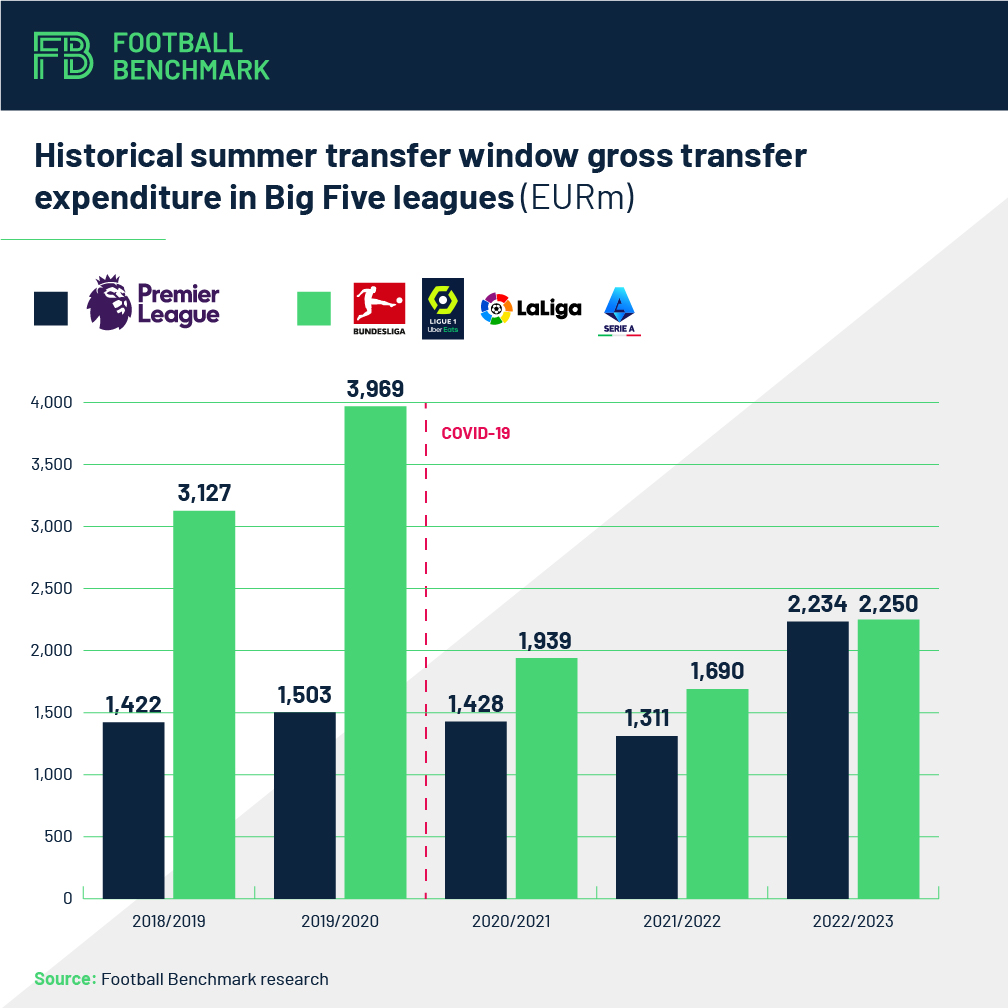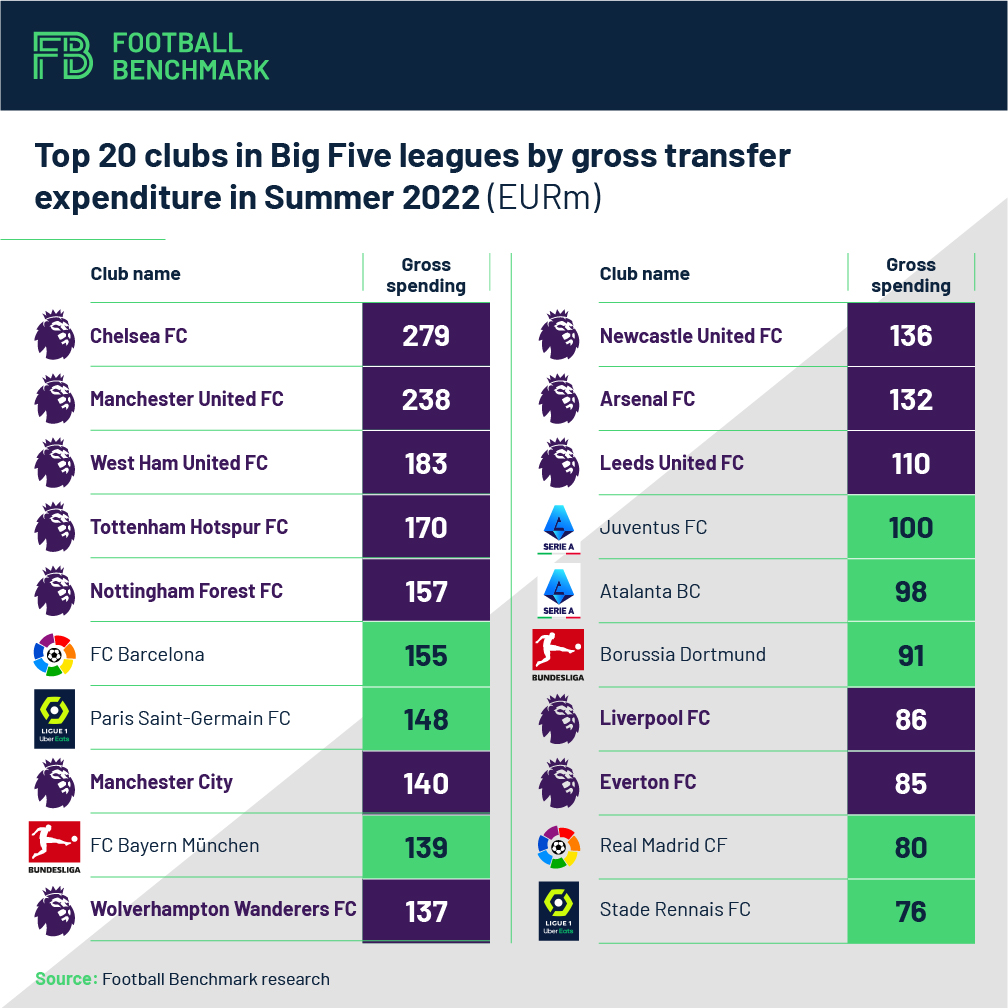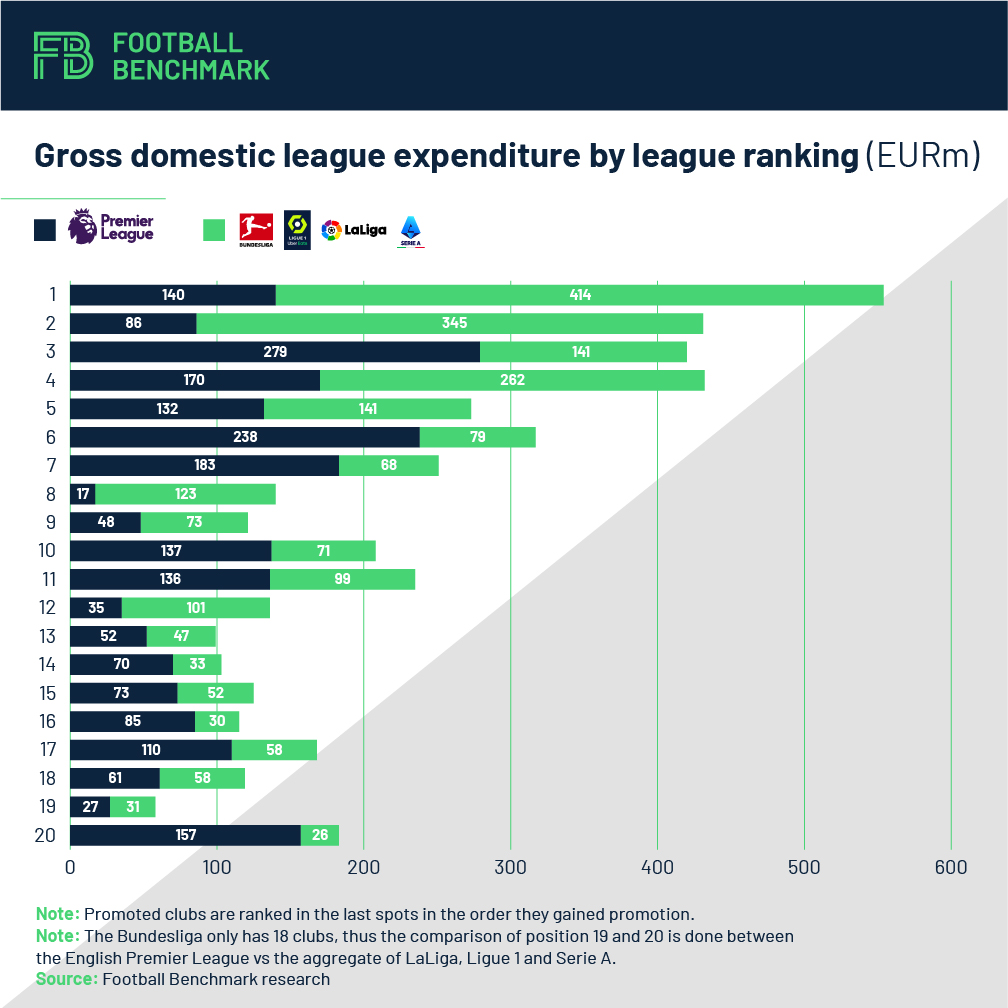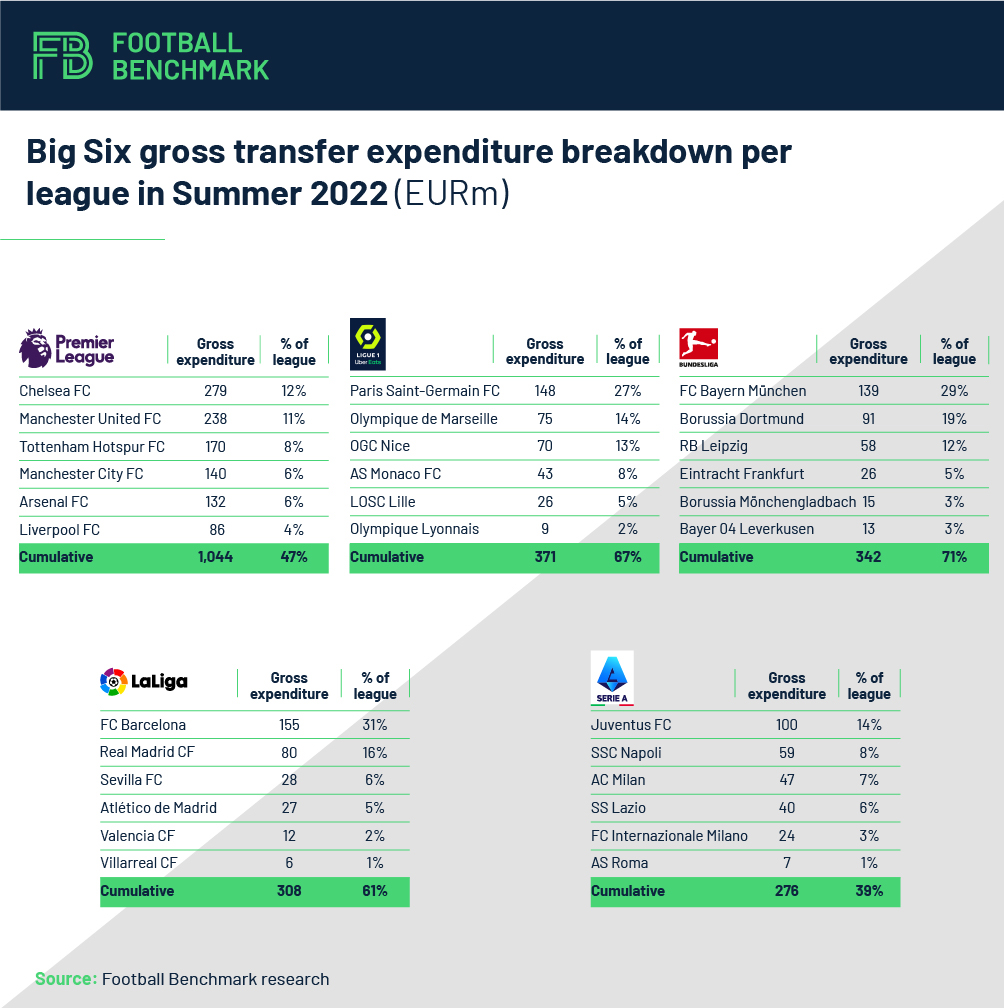In a recent article, we explored in great detail the transfer dealings of the biggest clubs in the English Premier League (EPL) during past transfer periods, including the 2022 summer window. As a continuation of that investigation, we are undertaking an analysis of the EPL’s transfer spending in the context of the Big Five European leagues, pitting the English clubs against their closest counterparts on the continent.
Why does the EPL merit special treatment, if all Big Five leagues fall under the same umbrella term? We have examined from various angles how the English Premier League could be considered a ‘super league’ in another previous article, but the same conclusions are also evident from an investigation only into data from past transfer windows.
Gross expenditure in the five most recent summer transfer windows demonstrates the robustness and financial might of the EPL. Prior to the COVID-19 pandemic, the four other Big Five leagues combined for more than double the Premier League’s gross transfer spend. However, since the pandemic, gross transfer expenditure in the rest of the Big Five leagues went down by half and stagnated, while it returned to a path of growth once again in the EPL, eclipsing pre-pandemic figures in the 2022 summer window. What is also staggering is that the EPL alone spent as much as the other four leagues combined in the most recent summer period. Thus, all signs indicate that the Premier League is conducting player trading business in a wholly novel way compared to their rivals.

Focusing on the clubs with the largest transfer expenditures in Summer 2022, 12 EPL clubs are in the top 20, and a staggering seven are in the top 10.

Two American-owned clubs are in the top spots: Chelsea FC (EUR 279m) lead the ranking after spending record amounts on transfer fees under new US ownership, with Manchester United FC (EUR 238m) following closely behind as a result of the club having thrown its weight behind its new manager, Erik ten Hag, in the transfer market, breaking the Dutch Eredivisie transfer record in the process through the acquisition of Antony for EUR 95m. It is surprising to see non-Big Six clubs so high up in the rankings, especially newly promoted Nottingham Forest, who became the highest spending promoted club in the history of the sport (EUR 157m).
FC Barcelona (EUR 155m) represent La Liga in sixth place after a tumultuous summer which saw them strengthening the squad with the likes of Robert Lewandowski and Raphinha, among others. Coming in one spot lower are PSG (EUR 148m), who worked tirelessly in the market to reinforce the squad after Kylian Mbappé’s contract renewal. Finally, the last club outside of the EPL in the top 10 is Bayern München (EUR 139m), who have retooled their squad with Sadio Mané and Matthijs de Ligt. The highest spending Italian s were Juventus FC (EUR 100m), who rank 14th.
Despite EPL clubs spending the largest gross amounts, there are three clubs from the league who have recorded some of the largest net transfer profits last summer, meaning they sold players for bigger fees than they paid out to other clubs. Coincidentally, Chelsea FC played a large part in all three clubs' transfer activities as they purchased Marc Cucurella from Brighton, Wesley Fofana from Leicester City and Raheem Sterling from Manchester City, boosting them to third, fourth and fifth in the ranking of most profitable clubs in the transfer market, with only AS Monaco and LOSC Lille outperforming them.
Juxtaposing the gross transfer expenditure of clubs who finished in the same league position in the EPL and the other Big Five leagues, with the freshly promoted clubs occupying the places of those having been relegated, offers a further contrast. Even in such a lopsided comparison, EPL clubs manage to outspend their similarly ranked counterparts in 12 out of 20 instances.

Unsurprisingly, at the top of the table the data show that four similarly sized European clubs outspent a single English club: this happens in four instances in the top 6 and six times in the top 10. At these highest positions in the rankings, we are setting as rivals of English clubs not only one but several of the largest clubs in Europe such as Real Madrid or Juventus, thus the fact that there are occurrences in which the EPL still outspends their four peers together is a remarkable show of strength.
However, the true financial might of the EPL surfaces when examining the 10 clubs who finished in the lower half of their domestic divisions. Within the bottom 10, the Premier League dominates the comparison, with EPL clubs having a larger transfer spend eight times out of 10, on average recording gross transfer expenditures that are EUR 27m higher than the aggregate from the four comparable European leagues in the same league position.
Lastly, we analyse the spending of the top clubs in each of the five divisions in the 2022 summer transfer period. The colloquial use of ‘Big Six’ is most often used in the EPL, with other leagues having no such designations for their top clubs. As such, we have attempted to classify six clubs in each of the remaining Big Five leagues who could form a Big Six in their respective domestic divisions based on their sporting (historical and recent) and financial performance.
After having demonstrated how EPL clubs are capable of much larger gross transfer expenditures, it comes as no surprise that the EPL Big Six spent EUR 1.04 billion, almost as much as the EUR 1.30 billion the 24 other Big Six clubs paid last summer.

Furthermore, we have examined the gross transfer spending of the Big Six as a percentage of total league expenditure. One club’s share of total league gross transfer expenditure would be 5% in a hypothetical situation in which each club has the same gross transfer spend, amounting to 30% if considering six clubs1. These figures should serve as the benchmark for the analysis below.
The highest figure amongst the five leagues is seen in the Bundesliga, at 71%, while the lowest is in Serie A (39%), with the EPL in the middle of the pack at 47%. Overall, these numbers indicate that top clubs in the leagues considered spend more than an equally proportional share of the total league-wide gross transfer expenditure, albeit to different degrees. Ending the analysis here would suggest that the Big Six in the Bundesliga, Ligue 1, and La Liga are much “bigger”. Similarly, it would suggest that Serie A is the most balanced league in terms of gross transfer expenditure equity.
However, examining each of the Big Six clubs' transfer expenditure individually reveals deeper insights. First off, despite being the biggest spender in the EPL, Chelsea only spent 12% of the league’s total, the lowest among clubs who are top spenders in their own divisions, while FC Barcelona, PSG, and Bayern all outlaid more than a quarter of their league’s aggregate. The EPL also exhibits the smallest delta of transfer spending percentages between first and sixth (8%), appearing to be the most equitable, while on the other hand the biggest difference is seen for La Liga (30%).
In the Spanish topflight, indeed, Real Madrid and Barcelona account for 47% of their league's gross transfer expenditure – the same percentage as the Big Six in the EPL – with a significant drop off after the two giants. Similarly, Bayern München and Borussia Dortmund represent almost half of total Bundesliga transfer expenditure, and adding RB Leipzig’s increases the share to 60%. Meanwhile, in Ligue 1, PSG were by far the biggest spenders and combined with OM and Nice, their transfer dealings add up to 53%2 of gross league transfer expenditure. Finally, in Serie A, Juventus appear to have a slight advantage over their rivals with 14% of total league gross spend. As such, it is evident that spending power is much more concentrated in the other Big Five leagues, with the majority in possession of one, two or three big spenders in percentage terms.
In conclusion, our investigation of gross transfer expenditures in the 2022 summer transfer window demonstrates that the playing field is not even: the financial prowess of the English Premier League equips them with the ability to spend as much on their own as the next four biggest European football leagues. Based on the most recent transfer period, we also confirmed that the Big Six English clubs are aptly named as they are the closest in terms of relative transfer spending, while in the other four leagues, the concentration of spending power is in the hands of fewer clubs.
1 These percentages, 6% and 33%, are slightly different in the Bundesliga as the size of the league is 18 clubs.
2 Percentages in the image above were rounded to the nearest whole percentage.


